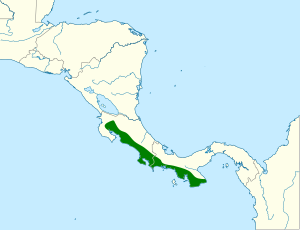Black-hooded antshrike facts for kids
Quick facts for kids Black-hooded antshrike |
|
|---|---|
 |
|
| Male | |
 |
|
| Female | |
| Conservation status | |
| Scientific classification | |
 |
The black-hooded antshrike (Thamnophilus bridgesi) is a cool bird that lives in the warm, wet forests of Costa Rica and Panama. It's part of a bird family called Thamnophilidae, which includes many types of antbirds. This bird gets its name from the male's dark, "hooded" head.
Contents
About the Black-hooded Antshrike
The black-hooded antshrike is a medium-sized bird. The male has a mostly black head and chest, which looks like a hood. Its body is usually a mix of gray and black. The female looks a bit different, with a more brownish or reddish-brown color on her head and body. Both male and female birds have unique patterns that help them blend into their forest homes.
Where They Live
These birds are found only in a specific part of Central America. You can spot them in the tropical forests of Costa Rica and Panama. They prefer places that are:
- Warm and wet lowland forests
- Mangrove forests, which are special forests that grow in salty water
- Areas where forests used to be, but have changed a lot
They like these habitats because they offer plenty of insects to eat and good places to build their nests.
What They Eat
Black-hooded antshrikes mainly eat insects. They are often seen moving through the trees and bushes, looking for bugs. They might also eat other small creatures they find in the forest.
Discovery and Naming
The black-hooded antshrike was first officially described by an English zoologist named Philip Sclater in 1856. When a scientist describes a new species, they give it a special scientific name. For this bird, the name is Thamnophilus bridgesi. This name helps scientists all over the world know exactly which bird they are talking about.
Conservation Status
The black-hooded antshrike is listed as "Least Concern" (LC) by the IUCN. This means that, for now, there are enough of these birds in the wild, and they are not considered to be in danger of disappearing. However, it's always important to protect their forest homes to make sure they stay safe for the future.
See also
In Spanish: Batará negruzco para niños


